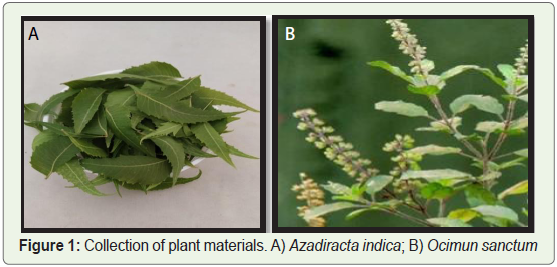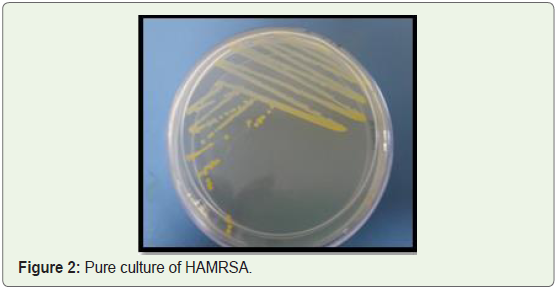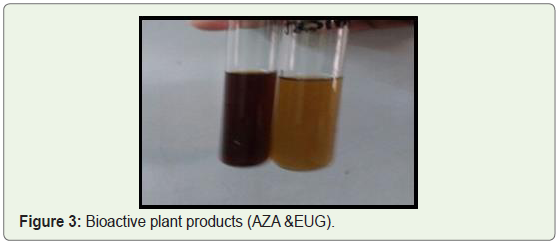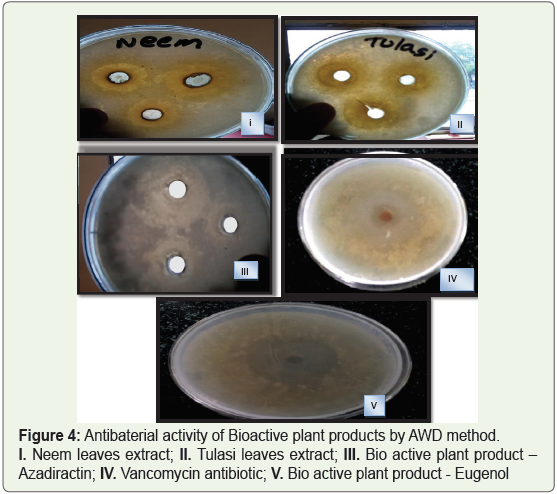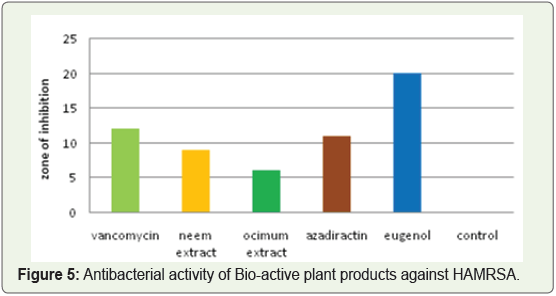Research Article
Extraction and Evaluation of Bio - active plant products against HAMRSA
Bai B1, Madhuri A1, Sudha SS2*
1Department of Microbiology, Government Degree College for Women, Begumpet, Hyderabad, Telangana, India
2Department of Microbiology, Dr. N.G.P. Arts & Science College, Coimbatore, Tamil Nadu, India
*Corresponding author: Sudha SS, Department of Microbiology, Dr. N.G.P. Arts & Science College, Coimbatore,
Tamil Nadu, India; E-mail: drngpmicro@gmail.com
Copyright: © Bai B, et al. 2022. This is an open access article distributed under the Creative Commons Attribution License, which
permits unrestricted use, distribution, and reproduction in any medium, provided the original work is properly cited.
Article Information: Submission: 09/05/2022; Accepted: 13/06/2022; Published: 16/06/2022
Abstract
Microbial drug resistance is increasing worldwide and is currently considered as major threat to human healthcare. To overcome this problem, several
new drugs are being tried to manage and to control the pathogenesis of these microorganisms. Currently, natural sources are being investigated for novel
antibiotics. Medicinal plants are good sources of bio-active compounds and chemical structures that have potential beneficial effects. Azadiracta indica
(Neem) is a multipurpose tree with more health benefits; the plant shows antimicrobial effects. Azadiractin (AZA) is one of the main bio-active compounds
present in neem. AZA shows anti malarial activity, and anticancer activity. Ocimum sanctum L (Tulasi) has anti-stress and anti-oxidant activity. Eugenol
(EUG) bio-active compound of Tulasi, has therapeutic potentials in cardio vascular system, central nervous system, blood bio chemistry, and immune
system. The main objective of this study is to check the antibacterial activity of bio-active compounds extracted from neem and Tulasi against HAMRSA.
Keywords
Azadiracta indica; Ocimum santum; AZA; Eugenol; ZOI
Introduction
Antibiotic resistance by microbial pathogens is considered a
major threat to mankind [1]. Methicillin-resistant Staphylococcus
aureus (MRSA) is responsible for causing life-threatening diseases in
nosocomial infections. The increase in drug resistance worldwide has
prompted researchers to find novel antibiotics from natural sources
for controlling the spread of infection. Plant-based products are
cheaper and can be used as an alternative to synthetic drugs. Screening
of medicinal plants for biologically active compounds gives clues to
develop newer antimicrobial agents, after which possible chemical
manipulation provides new drugs to treat infectious diseases [2].
Neem (Azadiracta indica) used in traditional medicine for
the treatment of various diseases. Neem has diverse therapeutic
applications such as antiviral, antimicrobial, antibactericidal,
antipyretic, anticancer, antidiabetic, and immune modulatory
activities [3]. The bioactive compounds obtained from neem leaf
extract being effective in the treatment of anorexia and skin problems. Azadiractin (AZA) is the most abundant and relevant compound
present in Azadiracta indica [4].
Ocimum sanctum L. (syn. O. tenuiflorum L.) has been extensively
used in the Ayurvedic system of medicine for various ailments. The
extracts from leaves of ocimum (Tulasi) have to inhibit the growth
of gram-positive bacteria and gram-negative bacteria showing
antibacterial activity. Tulasi leaves possess antifungal, antiviral
activity and anti-tubercular activity and inhibits in-vitro growth of
Mycobacterium tuberculosis [5].
The bio-active compound of leaves of the Ocimum sanctum L.
is Eugenol (l-hydroxy-2-methoxy-4-allylbenzene) which is mainly
responsible for the therapeutic potentials of cardiovascular system,
urinary system, reproductive system, immune system, gastric system,
blood biochemistry, central nervous system [6]. The volatile oil of
O. gratissimum contains mostly thymol and eugenol as bio-active
compounds and shows antimicrobial activity [7].
Materials & Methods
Collection of plant material:
Fresh plant material were collected Azadirachta indica (Neem),
Ocimum sanctum L (Tulasi), tree located at Hyderabad, Telangana.
The identification was done by using a plant sample from the
herbarium (Figure 1).The moisture content determined by using equation - 1
Where W1 = weight of plant leaves before drying, W2 = weight of
plant leaves after drying [8].
The dried leaves were pulverized to coarse powder. The leaves
powder was stored in air tight container in dark at room temperature
to prevent oxidation and contamination. This was done separately for
both Neem leaves and Tulasi leaves.
Extraction of bioactive plant products from Neem and Tulasi leaves:
10 grams of leaves powder was placed carefully into the top of the
thimble subsequently 150ml of pre-heated solvent was poured into
the Soxhlet apparatus and extraction was carried out under n-hexane
to ethanol ratio (50:50 v/v) at 70ºC for 3 hrs. The obtained extracts
were filtered using wattman filter paper and evaporated using rotary
evaporator. The extracts were stored in air tight container at 4ºC
separately for future use.Azadiractin and Eugenol:
These compounds were obtained from commercial suppliers.Isolation of test organism:
Pus samples were collected from Research units, hospitals
and cultured on Muller-Hinton agar medium (Figure 2). The
presumptive isolates were sub-cultured on MHA medium for
another 24hrs. The suspected colonies were used for Identification
of Staphylococcus aureus on the basis of microscopic examination,
cultural characteristics and bio chemical reactions based on Bergey’s
manual of systemic bacteriology.Preparation of stock solution:
To carry out the antimicrobial activities against selected organism
(HAMRSA), the stock solution was prepared by adding 0.5 grams of
leaf extracts (Neem & Tulasi) dissolved in 10 ml DMSO (100mg/ml), 0.5 grams of the bioactive compounds (AZA & EUG) dissolved in 10
ml DMSO (100 mg/ml) [9]. The solution was then centrifuged and
supernatant was collected in separate tube. These tubes were covered
with paraffin wax and stored at 4ºC for further work.Determination of antimicrobial activity by AWD method:
The bio-active plant products (Neem leaves, AZA & Tulasi
leaves, Eugenol) were tested for antimicrobial activity against the test
organism (HAMRSA) by agar well diffusion method (AWD) (Figure 3). The bacterial strain was grown in nutrient broth for 4 - 8 hrs and
the turbidity of the broth culture was adjusted to 0.5 McFarland units
(2X106). Mueller Hinton agar plates were prepared and about 0.1 ml
of bacterial cultures was spread uniformly. Agar surface was cut with
the help of sterile cork borer having a diameter of 6mm size. After
this, 50μl of original stock solution was added by using micropipette
in each well. The final concentration of the compounds in the well
was 1 mg/ml. The extract was allowed to diffuse in the medium; the
prepared plates were left at room temperature for 30 minutes and
then incubated at 37ºC for 24 hrs. Vancomycin antibiotic (100mg/
ml) was used as positive control and Dimethyl Sulfoxide (DMSO) as
a negative control [10].Results & Discussion
The emergence of microbial drug resistant pathogens has become
a huge global threat all over the world. The development of effective
control measures for the treatment and management of drugresistance
bacteria is the need of the hour.
The antibacterial activity of methanol extracts of bio-active plant
products was investigated using agar well diffusion method against
HAMRSA (Figure 4). The antibacterial activity of bio-active plant
products (neem leaves, AZA & Tulasi leaves, Eugenol) compared with
the zone of inhibition of vancomycin. The zone of inhibition obtained
by the vancomycin antibiotic was 12mm in diameter, & with neem leaves extract, it was 9 mm, with Tulasi leaves extract, it was 6 mm,
with Azadiractin 11 mm diameter, and with Eugenol 20mm diameter
was obtained (Figure 5). This pattern of antimicrobial resistance
was very diverse. In similar studies conducted by Venugopal (2021)
[9], the zone of inhibition obtained with eugenol against MRSA was
15mm, whereas Coralie P. et al (2018) [11] obtained the zone of
inhibition of 3.8 mm with eugenol against S.aureus. Maragathavalli
et al. (2012) conducted experiments using neem extracts in methanol
and ethanol solvents and obtained the same zone of inhibition of
12 mm in both cases [12]. Sivaramakrishnan (2015) used Ocimum
sanctum extract against S.aureus and obtained the zone of inhibition
of 25mm [13].
Figure 4: Antibaterial activity of Bioactive plant products by AWD method.
I. Neem leaves extract; II. Tulasi leaves extract; III. Bio active plant product –
Azadiractin; IV. Vancomycin antibiotic; V. Bio active plant product - Eugenol
The medicinal plants are rich in secondary metabolites (potential
source of drugs) and essential oils of the therapeutic importance,
used in traditional system of medicine [14]. A.indica showed good
antibacterial activity with greater potential of bioactive compounds
like Azadiractin shows antimalarial and anticancer activities.
Azadiractin has the ability to induce anti- proliferative effect in
proteins and involved in cell cycle, transduction and apoptosis [15].
Ocimum sanctum L used as traditional medicine such as analgesic,
antimicrobial, anticancer, antidiabetic, antifertility, antiasthamatic
and anti stress agents. Several studies have been carried out by Indian scientists and researchers suggest the role of essential oil
and Eugenol which is phenolic compound (1 –hydroxy-2 methoxy
– 4- methylbenzene) in therapeutic importance. Eugenol possesses
membrane stabilizing properties on synaptosomes, Erythrocytes and
mast cells, in the treatment of rheumatoid arthirities, antiulcerogenic
action.
Conclusion
The traditional medicine is safe when compared to synthetic
drugs. The bio active plant products like neem extract, Tulasi extract,
Azadiractin and eugenol have antibacterial activity against HAMRSA.
Many of the existing synthetic drugs cause numerous side effects;
hence plant-based newer drug compounds with minimal side effects
can be used for therapeutic applications.

